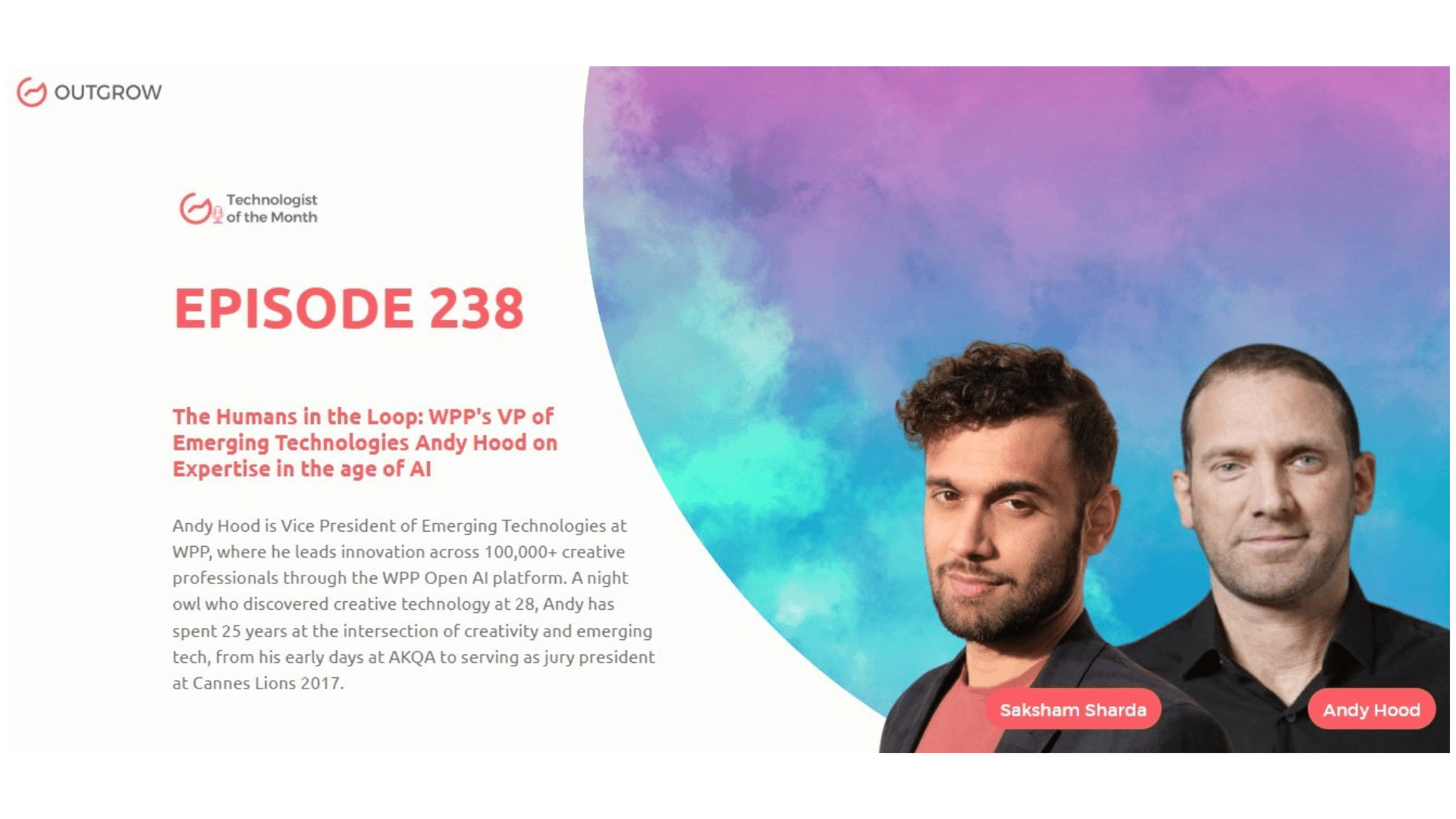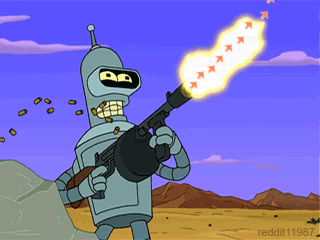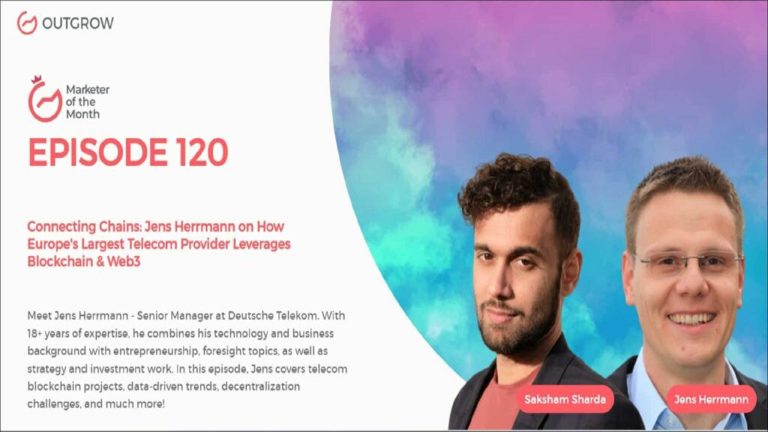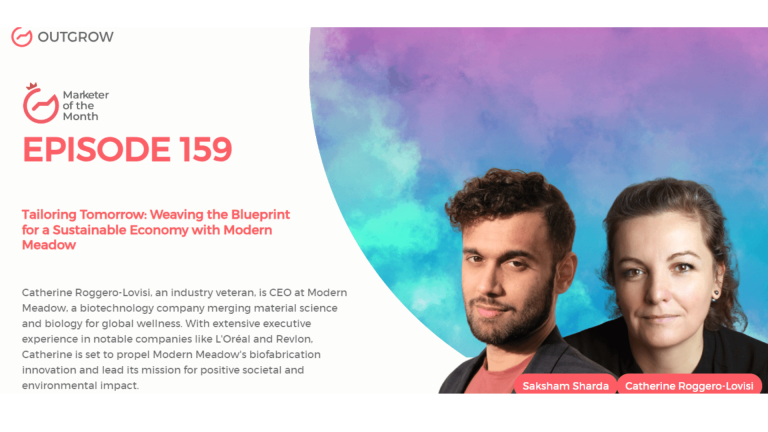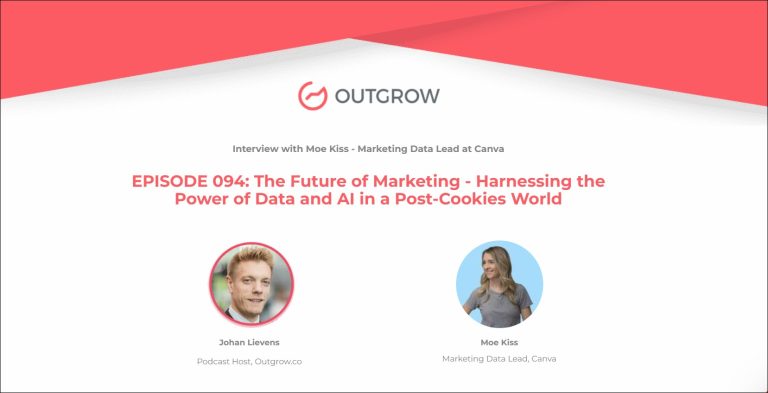EPISODE 238: Marketer of the Month Podcast with Andy Hood
Table of Contents
Hey there! Welcome to the Marketer Of The Month blog!
We recently interviewed Andy Hood for our monthly podcast – ‘Marketer of the Month’! We had some amazing insightful conversations with Andy and here’s what we discussed about-
1. Why generative AI is transforming advertising and marketing.
2. The role of human creativity in an AI-driven world.
3. How AI does the production legwork, not creative thinking.
4. M-shaped professionals: The future of creative tech.
5. WPP’s creative technology apprenticeship program explained.
6. WPP Open platform: Democratizing AI for creative teams.
About our host:
Dr. Saksham Sharda is the Chief Information Officer at Outgrow.co He specializes in data collection, analysis, filtering, and transfer by means of widgets and applets. Interactive, cultural, and trending widgets designed by him have been featured on TrendHunter, Alibaba, ProductHunt, New York Marketing Association, FactoryBerlin, Digimarcon Silicon Valley, and at The European Affiliate Summit.
About our guest:
Andy Hood is Vice President of Emerging Technologies at WPP, where he leads innovation across 100,000+ creative professionals through the WPP Open AI platform. A night owl who discovered creative technology at 28, Andy has spent 25 years at the intersection of creativity and emerging tech, from his early days at AKQA to serving as jury president at Cannes Lions 2017.
The Humans in the Loop: WPP’s VP of Emerging Technologies Andy Hood on Expertise in the age of AI
The Intro!
Saksham Sharda: Hi, everyone. Welcome to another episode of Outgrow’s Marketer of the Month. I’m your host, Dr. Saksham Sharda, and I’m the creative director at Outgrow. co. And for this month we are going to interview Andy Hood, who is the VP of Emerging Technologies at WPP.
Andy Hood: Great to be here. Thank you.
Don’t have time to read? No problem, just watch the Podcast!
Challenge yourself with this trivia about the exciting topics Andy Hood covered in the podcast.
Or you can just listen to it on Spotify!
The Rapid Fire Round!
Saksham Sharda: Alright, we’re gonna start with the rapid fire round. Just to break the ice, you can only answer with one word or one sentence, and if there’s something you don’t want to answer, you can just say pass. The first question is, at what age do you want to retire?
Andy Hood: I have no intention of retiring anytime soon.
Saksham Sharda: How long does it take you to get ready in the mornings?
Andy Hood: About an hour.
Saksham Sharda: Most embarrassing moment of your life?
Andy Hood: Most of them.
Saksham Sharda: Favorite color?
Andy Hood: Blue.
Saksham Sharda: What time of day are you most inspired?
Andy Hood: The evening.
Saksham Sharda: How many hours of sleep do you need?
Andy Hood: About five or six.
Saksham Sharda: The city in which the best kiss of your life happened.
Andy Hood: Las Vegas
Saksham Sharda: Pick one. Mark. Zuckerberg or Elon Musk.
Andy Hood: Pass.
Saksham Sharda: How do you relax?
Andy Hood: Lots of things. Music, poker, cricket. Lots of things.
Saksham Sharda: How many cups of coffee do you drink per day?
Andy Hood: Not coffee. I’m a big tea drinker. Probably five or six.
Saksham Sharda: A habit of yours that you hate?
Andy Hood: Bite my nails.
Saksham Sharda: The most valuable skill you’ve learned in life.
Andy Hood: Be nice to everyone.
Saksham Sharda: Your favorite Netflix show.
Andy Hood: Wednesday.
Saksham Sharda: Are you an early riser or a night Owl?
Andy Hood: Night owl.
Saksham Sharda: One word. Description of your leadership style.
Andy Hood: Collaborative.
Saksham Sharda: Top priority in your daily schedule.
Andy Hood: Getting up probably
Saksham Sharda: Ideal vacation spot for relaxation.
Andy Hood: Sri Lanka.
Saksham Sharda: Key factor for maintaining a work-life balance.
Andy Hood: I am loving what you do.
The Big Questions!
Saksham Sharda: Alright, that’s the end of the rapid-fire round. I’ll go on to the bigger questions, which you can answer with as much time and ease as you like. If you could go back in time and hand one piece of today’s emerging technology to yourself at AKQA, what would it be, and what mischief would you get up to with it?
Andy Hood: It would have to be generative AI. Because you could do most anything with it and it’d actually be hard, and to stay out of mischief, I think with generative AI, back in my old days, it would be harder to create it.
Saksham Sharda: And if you now had a chance to replace one of your colleagues with an AI, which colleague would go first?
Andy Hood: I couldn’t possibly. AI is decades away from replacing them.
Saksham Sharda: No worries.
Andy Hood: They might see it.
Saksham Sharda: What was the experience like being on the jury at the Cannes Lions 2017?
Andy Hood: It was amazing, actually. I was very lucky. I had a brilliant jury. The discussions were fantastic. Cannes has a reputation for juries, kind of arguing well into the early hours, and has stalemates and things. I didn’t have any of that. And a really good jury, a really good time. It was fascinating being behind the scenes. And, being president obviously was a bit of an honor, and doing the speech, etc. So, it was great actually seeing a huge span of work from around the world. Whereas at AKQA at the time, you’re very funneled on AKQA work and actually getting that opportunity to see that artwork, but then discuss it with a brilliant jury. Yeah, definitely a week to remember.
Saksham Sharda: So, the next question is, how do you see AI transforming the creative process in advertising and marketing today?
Andy Hood: So I, already, am transforming a lot, and it’s such a foundational technology. I mean, AI itself has seeped into all our lives without you really seeing it. It’s in so many of the apps and things that you use. What we see now is generative AI doing the legwork in the middle. Basically, so there’s a lot of perception, I think, of generative AI that it does more. Like you, someone could go in who isn’t a creative or an artist and generate films, images, and things on their own. And the technology will just do it. The technology is mind-blowing. You know, only a handful of years ago, I wouldn’t have believed what you see, but still, the human ingenuity, the spark at the beginning, and then crucially, the experience, knowing what good looks like at the end.
Andy Hood: So I’ll give you an example. I might use Google Voe three, which is a, you know, top-of-the-range video generator at the moment. And I’ve worked with creative people for a long, long time. I can, and I’m good with AI. I could generate a scene of a video there, and it would probably be okay. People would, and most people would think it was quite good, but we worked with a director, and that director would probably look at it and put it apart for framing, pacing, and lighting, and everything else. Because I’m not a writer, I’m not a director, I’m not a cinematographer, I’m not a sound designer, so I don’t really understand what good looks like in those things. So you’ve gotta have something to aim at and you’ve gotta know when you’ve got it. Basically, the middle bit, you can do a lot of that legwork production things with AI, but it’s about AI being part of the production process or wrapping a production process around it.
Andy Hood: So, what’s happening in my work environment right now at WPP, which is a huge organization. There are creative agencies, media agencies, all kinds of things; a hundred thousand people or more are creating a platform that has the tools in the platform. It’s called WPP Open. It’s got all the major generative AI models in it with a user interface. That means that everybody in the network has access to use these tools equally and safely. But it’s the people who are using the tools, not the other way round. And I would expect that to continue. It’s very hard to look ahead. This space is changing so dramatically and so quickly. But right now and for the foreseeable future, I see it doing a lot of the legwork in the middle, basically, but with people wrapped around it.
Saksham Sharda: But as you say, even if someone is not known, a sound director, or like a director, etc, they can still go ahead and make something which might not be good, but it is something. And to what extent is the internet itself gonna get flooded with some things? How is that that gonna make it hard to stand out with something good?
Andy Hood: Yeah, it’s a great question because actually that’s, you know, I would say that is already happening. I mean, the channels themselves have fragmented and fractionized over so many years. There are so many of them. You know, there are, everything is a channel for advertising and AI, as you say, democratizes a lot of the creative process to people who wouldn’t traditionally have done it. And maybe you, you know, in some cases, a lot of cases, people are just gonna create these things and kind of churn them out. And yes, that means there will be a lot of noise. And yes, that increases the urgency, if you like, for brilliant, talented, creative people to create cut through. And that’s nothing new, really; cut through was talked about when I got into the industry 25 years ago. And having ideas that stand out, things that engage people differently, not just eyeballs, but actual engagement with what you’re doing, which is very different from just having a lot of things, you know, at a very low level flash before your eyes while you’re scrolling through something. I think that the human element actually becomes even more important in a world where everybody is producing content of that type. And therefore, the creative industry and the professionals within it relied upon it even more.
Saksham Sharda: Yeah, I guess the complaint I have would probably also be a complaint people had when the printing press was invented and everybody could write?
Andy Hood: It is definitely a situation that comes up. I mean, the scale of it now is the differentiator, but every time something new comes up, I mean, I was on a panel today that was titled, Is it the End of Advertising? As we know it, as a creative technologist, we are researching, implementing, and applying the latest things all the time. So it’s the end of advertising as I know it, roughly every five years or so, it’s very different AI, it creates it on a bigger scale, but I think the same thing largely applies.
Saksham Sharda: So, what are the key skills then that creative professionals should develop now to stay relevant in an AI creative industry that is changing so fast?
Andy Hood: Yeah, I think actually experimenting and playing with the models is vital. WPP, we encourage everyone really to get into the platform open that I talked about, to get in and use the tools because it’s, you know, as with any tools, if you wanna stay and advance in your career, you need to be using and understanding how the latest tools do the job. There is a specific aspect I think of AI, which is really interesting, which is agents creating agents or having agents that become part of your team. So an agent is an AI model, which is trained with a lot of very specialist information, that then kind of works as part of your team. So if you were doing a project campaign, a job, and that job was to do with cooking, then you could actually have an expert cook in your team as part of your team while you’re doing that work.
Andy Hood: It’s a terrible example, but you get what I mean. And that’s unique. Basically, you’ve always had to go out and find a very busy person, and so agents kind of democratize certain specialist knowledge and bring them into your team, and you can create those. So I think understanding where agents can fit into your team scenario, and how to build teams around them, and also how to interact with the models, how to get the best out of them, playing with different models, and understanding what the differences are between them. That’s really where I think just jumping in, it’s not really about, you know, reading and watching videos and doing coursework. It’s actually about getting your hands dirty with these things, and using them and experimenting.
Saksham Sharda: And to what extent does the fact that every generation costs money, even if it is a practice generation, influence this entire Dynamic?
Andy Hood: It’s definitely a concern. I mean, we need to, it’s something that we, we would look at the companies that are creating the models, and we want those energy costs to come down without a shadow of a doubt. You know, it’s very interesting that I think even saying thank you to a model and getting a response out of it, you know, it takes up energy, and it’s something we have to be conscious of. Knowing how big, you know, energy, climate, and the rest of it. It’s definitely a concern, and it’s an area I think of innovation that we would be hoping is fast-tracked.
Saksham Sharda: So, what does your typical day at WPP look like? You wake up in the morning, and then?
Andy Hood: Yeah, I’m not sure there is a typical day. I’m very lucky and have been really fortunate throughout my career as a creative technologist to be working with people who are quite diverse in terms of their experience. If you had 25 creative technologists in a room, no two of them would be the same in terms of their skills, their passions, and their experience. And I’m surrounded by these people at WPP, so I could be talking to someone about AI, I could be talking to someone about VR, you know, or virtual production or robots. And that could happen at any time of any day. And being central at WPP, being part of the hub with all of the agencies and dealing with all of the agencies means that I never really have any idea what problem is gonna be thrown at me at any point. Usually, we have our creative technology apprenticeship at WPP, which is a huge part of our transforming into the future by bringing talented artists and creative people in, and then teaching them new skills with the latest technology, the latest models, and having those people around the network. I’m generally dealing with those people quite a lot of the time. So it’s incredibly varied. And to be honest, it’s that variety that keeps me passionate about what I do.
Saksham Sharda: Tell me more about the apprenticeship program. How does it work? Who are you looking for?
Andy Hood: Yeah, it’s fantastic. I’m privileged to work on this with two amazing people at WPP, Perry Nightingale and Kat Sullivan. And Kat Sullivan was lecturing at NYU when she joined WPP to help put this together. And the idea was that you have a lot of work, that is where the concept for that work has come up within agencies or by creative technologists who might be a bit of a lone wolf within an agency, but then the actual development of that work happens outside. We really wanted to rebuild creative technology capability within WPP, but to find creative people who are artists first and foremost, but who have a passion for technology, which is what I think a creative technologist is, as a creative person with a passion for technology. And then be able, because of the partnerships we have at WPP, with the likes of Google, Meta, and Microsoft, to teach them the very latest work and build an army of these people.
Andy Hood: And partly that helps us because you talked about the transformation of the future with generative AI. Well, there’s a term which I’ve become familiar with fairly recently, of people being m-shaped, and m-shaped people have a foundation of knowledge that they can apply in lots of different areas, hence this kind of mha term I’d heard of people being T-shaped or whatever from recruitment and whatever. But m-shape people, really, I am kind of what creative technologists are. So I think that AI, being a foundational technology that gets applied in lots of different areas, means that this is a bit of a boom time from a creative technology point of view. And these people have amazing futures in front of them. Hopefully, we can manifest that at WPP.
Saksham Sharda: And so what advice would you give to creatives who are just starting to experiment with AI tools today?
Andy Hood: Really, it’s got to be about experimenting and diving in. You know, that’s the way that you learn. It’s really the way that I think most people learn, with almost anything. Umut learning the tools, nderstanding, I think the, where the expertise beyond your own expertise needs to come to the table, because if you don’t, that sense of knowing what good looks like, if you’re trying to create for a medium and as an aspect of that medium that you are not familiar with, then it’s hard to know whether what you’ve got is of the standard that you need it to be. So understanding kind of where the edges are, because where the edges are is where you and your team members come in, but definitely experimenting, you know, getting in and playing with these things, and then staying up with the latest models as they come out, which they are gonna come out thick and fast, right? And you come up with a workflow, a pipeline now that that feels like it’s best in class, and the new model comes out, and you’ve gotta create a new one, staying on top of that really, but doing it by actually jumping into the sandpit and playing with it.
Saksham Sharda: Could you share some insights from your experience working on high-profile projects like the hybrid Metaverse concert for Bastille or the IBM Watson-powered campaigns?
Andy Hood: Yeah, well, the Watson one, that feels like a lifetime ago. That’s about 2017, which feels like another era. But I think in each case, Innovation is a word that gets used a lot in a lot of different contexts. And like many words, I think it becomes a word that’s easier to throw around. And for me, using a technology for the thing that the technology was invented for is good. It’s advanced, but it’s not really innovating in as much as the innovation is in the technology rather than in the application. So, actually, as a creative technologist and working with a bunch of creative technologists, finding innovative ways to apply the technology is the really interesting part of the job. And in both of the two that you’ve mentioned, the, the Watson project with IBM Watson, one of the first instances of that being commercially available, and it was used as a, as a kind of a semi-autonomous Twitter responder for a brand seeking out conversations offering help if that help is effective, giving it that’s 2017 with Bastille at WPP which was virtual production, using a big screen unreal engine to create environments.
Andy Hood: Filming that with the band, creating VR experiences out of it was taking the tools, which are themselves innovative, but coming up with applications of the tool that show where they can go. And those things are inspiring to work on. Generally speaking, when I’m involved in those things, I’m involved with a whole lot of other people who are inspiring to work with. It’s definitely not, you know, an individual with a vision and then everybody else doing, you know, what they’ve been told to do. It’s a bunch of people all bringing lots of different views and visions to the table, and you know, that’s what really kind of gets your mind working basically. So those are high points for sure.
Saksham Sharda: So, looking back at the creative technologist journey that you’ve personally had, is there something that you would do differently that you would also advise others to?
Andy Hood: The thing I would do differently if I could do it again would be to do it earlier. To be honest, I was, I mean, I didn’t really know about the industry, and actually, a lot of people don’t. Creative technology is not, I think, as clearly defined as lots of other disciplines are. That means that people know what they’re looking for and they know where they’ve found them, recruiters know what they’re talking about, all these kinds of things. It’s quite muddy. And so I didn’t know this field existed. Technology for me has been the thing that’s enabled me to be creative. These hands have no craft skills. So you know, I got into it when I was about 28, and so I was doing other things until I was 28, and I would take that time and put it here.
Andy Hood: That’s not something I can tell everybody else to do. So what I would do for everybody else really is if you are a creative person, a designer and artist in any form, I would just have a look at the landscape of technologies that are out there, that’s not just AI. There are a lot of other things, a lot of other tools, and see how they impact what you’re doing, what you could do, how big the world becomes if you start working with some of these tools. And if that interests you, if that becomes something that’s a passion for you, then, you know, the marketing industry is a fantastic place to be in. Marketing, we are quite happy to work with the very earliest alpha versions of technology because, for us, it’s about putting something out there that people haven’t seen before.
Andy Hood: And you can’t wait five years for version three when it’s stable to do that. So as a creative technologist in marketing, you are constantly working with the very, very earliest forms of technologies, and that’s a very exciting place to be. And as a creative, that presents a lot of opportunities to do new things. So I think if you are an artist, if you’re a creative person, I would not shun the world of technology, but look and see what it offers, and then look and see what career it offers. Because of my experience, my life experience doing this is something I absolutely cherish. And I love the idea that lots of other people could have the same.
Saksham Sharda: So, I guess technology moves in exponential leaps, and it’ll continue moving faster and faster and faster. To what extent, then, does luck play a role in hitting the right thing at the right time?
Andy Hood: Huge, I wish more people would acknowledge the role of good fortune. And because I think I remember, I remember back in the day when, I don’t know if you remember the Lean Startup, when that was a thing, that was a book, it’s a very successful, popular book. And you would hear talks constantly by people who had followed this lean startup process and who’d done really well. And you’d hear from those people, who you wouldn’t hear from were the 99.9% of other people who’d followed the same process and for whom nothing had happened. Because somewhere on these people’s journey, they met the right person at the right time who had the right need, who said the right thing, or they overheard something, and whatever. And you, you catch lightning in a bottle. And I don’t think it’s a weakness to acknowledge the role of good fortune, actually.
Andy Hood: There’s an element of humility in that. It keeps grounded. I think that when I got into this industry, I was lucky to be in the right place at the right time. I got an AKQA very early, even AKQA, what a fantastic place that was to begin a career and to learn and grow. There were probably lots of other people who could have done it. So I do think that good fortune plays a big role. The thing you have to do, though, is recognize it when you’ve had it because that’s what allows you to make the most of it and develop with it. And I think people are surrounded by tiny opportunities all the time. And some people are aware of those and can grab one and run with it. And you’ve been lucky enough to get the opportunity, but you’ve then done something with it basically. So I think that the acknowledgement of luck and good fortune is actually an important thing.
Saksham Sharda: It reminds me of the T.S. Elliot phrase, science taken for wonders. You might have a sign, but if you don’t know what it means. It’s of no use to you.
Andy Hood: I didn’t know that quote, but I really like it. I’m a fan now.
Saksham Sharda: Yeah. Alright, so the last question for you is of a personal kind. What would you be doing in your life, if not this?
Andy Hood: I would be an entirely different person altogether. And I know that because I started doing it late because I started doing it when I was 28. There is a version of me at like 28 and under, and there’s a version of me post-28. And before 28, I had a job, lovely people. It was a job. And basically, and you know, I worked to be able to do the things I wanted to do post-28, the work was the thing that I wanted to do, and I kind of built my life around. It was a passion for me, and it allowed me to take things that were in my imagination and make them real because of the technology, which I couldn’t do before. So, yeah, I think I kind of have an idea of the person I would’ve grown to be. Hopefully, I’d have been okay, but I certainly wouldn’t have. UI don’t think I’d have been able to offer as much to others as I am now in the position with WPP and everything else. And that’s a real value to me. So I would probably have had some hobby or passion or something that I’d have poured myself into. But my working day, probably, would’ve struggled a little bit, to be honest.
Saksham Sharda: So, for people looking to make the change you made at 28, what should they do? Is your apprenticeship program one option? Is it like, how, how do they get about it?
Andy Hood: It can be the apprenticeship program. I’d have to say that we’ve done three cohorts now, basically, and each cohort’s 1 t, 16 people, so there’s roughly 50 people who’ve come into it now. In year one, Perry and Kate interviewed 15 people interviewed 30 people to take 15 people. And I would say actually that that, you know, 12 of those 15 were women, which is amazing because, you know, I haven’t seen enough of that in creative technology. In year two, it was about 150 to take 15, and in year three, it was nearly 300 to take 15. So it’s not the easiest thing to get into, but I think if you want a career as a creative technologist, you know, the apprenticeship is an amazing accelerator to a career, but it’s not the only one. But I think there are some good courses at some of the London universities, art schools, and things, such as Central Saint Martins. There are others, and those people have gone to. You know, there are several courses, D-N-A-D-I think run a I’m trying to remember what it’s called, night Shift, something like that. I could have that name wrong, but who trains people up? But getting a foot in the door is the thing. And it may take a while, you know, and it’s a competitive market out there. And creative technology, as I say, is not the clearest and most well understood, but there’s real value in it. Ai, I think, emphasizes that value. What I would say is that if you can get, if you can manage to get either placed into a course, signed up for something, or you get a foot in the door with an agency, and you meet someone in a meetup, there are creative technology meetups that happen.
Andy Hood: You’ve really gotta kick the door down and get in. And it’s the passion and energy that you have that allows you to do that. And everybody I’ve met who’s made a career in credit technology has done it by doing something else and then taking this enormous left turn; basically, that’s certainly true of Perry, whom I mentioned. It’s true of me. True of a bunch of others. So yeah, I think it’s been persistent. Keep looking around you, know, and keep up to date with the tools and technologies. If you are a credit person, then develop a portfolio, have things to show, you know, get in front of someone for 30 seconds, have something to say and to show, you know, make an impression. It’s probably quite tiring to keep doing that, but you just have to stick at it. And if you get a foot in the door, basically, you know, kick it down.
Saksham Sharda: Interestingly, creativity is what is required to go past the gatekeepers.
Andy Hood: A hundred percent. Absolutely. It’s a lot of people, I think, who have seen creative technologists and think of them as technologists because we tend to talk about the technology, but the reason that you can do the things with the technology that creative technologists do is because they’re creative, and the two really do come together.
Let’s Conclude!
Saksham Sharda: Thanks, everyone for joining us for this month’s episode of Outgrow’s Marketer of the Month. That was Andy Hood, who is the VP of Emerging Technologies at WPP.
Andy Hood: Great to be here. Thank you.
Saksham Sharda: Check out the website for more details and we’ll see you once again next month with another marketer of the month.
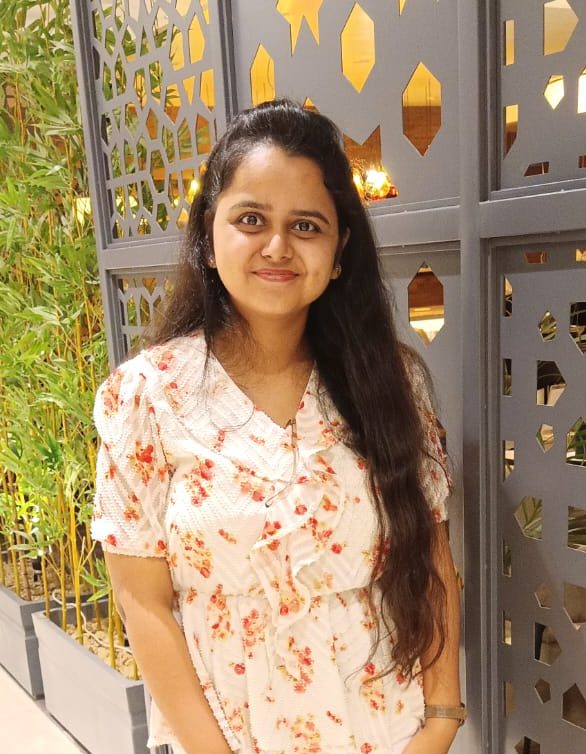
Muskan is a Marketing Analyst at Outgrow. She is working on multiple areas of marketing. On her days off though, she loves exploring new cafes, drinking coffee, and catching up with friends.

